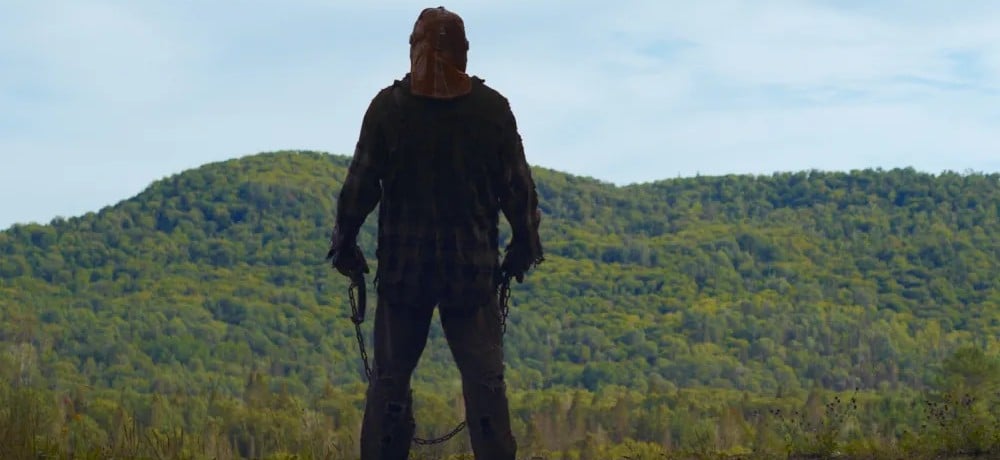


In A Violent Nature might be Canadian writer and director Chris Nash’s feature debut, but he’s hardly an untested rookie (and it shows). His ABCs of Death 2 segment “Z is for Zygote” teases his knack for producing practical effects and what to expect by the bucket full in his subversive Sundance slasher. Nash’s experience in effects departments, like serving as On-Set Creature Effects Supervisor for Psycho Goreman, translates into a slasher experience that stands pound-for-pound with modern masterclasses of mutilation like the Terrifier series. In A Violent Nature is one of the bloodiest, most punishing, and refreshingly original slashers in some time, but its unique approach will divide horror audiences — that’s the looming risk that comes along with shoot-for-the-moon ambitions.
Everything starts at the site of the “White Pines Slaughter.” Cinematographer Pierce Derks opens on a shot of rotted and mossy wood planks, remnants of a cabin or dwelling that have since decayed into ruin. Characters off-camera banter about some backwoods massacre, your typical campfire legend, but we never see them. We only hear their voices and catch an unknown hand swiping a dangling golden locket from a steel pipe. The rod starts to jiggle, being pushed upward, as we watch the zombified remains of a hulking brute emerge from the moist forest soil. Derks’ camera shifts focus to a behind-the-back perspective, and so begins our journey with a slasher villain as he sets out to reclaim his stolen property.
Nash’s curiosity about the supernatural motivations behind slasher villains propels In A Violent Nature. We’ve seen horror films shot from the killer’s point of view, like Behind the Mask: The Rise of Leslie Vernon or Tragedy Girls, but Nash strips away in-your-face meta commentaries and leaves us with nothing but the animalistic reality of choice and consequence. Lengthy stretches feel like Friday the 13th as reimagined by Chloe Zhao from Jason’s perspective, except without the copyright infringement. Actor Ry Barrett becomes the unearthed creature known as Johnny with chewed-away lips and milky dead eyes, mimicking that Voorhees style down to ratty flannels and an owl-like mask hiding his facial deformities. Nash then erases the “fun” elements of slashers — the Harry Manfredini scores, time spent getting to know dunderhead victims, cheesy fluff — and leaves us with the grotesque leftovers.
It’s an exercise in tense restraint, physical brutality, and the troubling psychology behind undead slashers that strikes clever highs yet sometimes struggles. The biggest turnoff will undoubtedly be sound design that pretends we’re using Johnny’s ears, which often catches snippets of conversations in the distance, nearly out of range. Dialogue is meant to be at a hush while the clunky sounds of machinery or car horns next to Johnny punish our eardrums, piercing the silence. We move at Johnny’s walking pace, hear what he hears, only exist in his one-track world, and aren't granted any cinematic graces that would “liven” the experience because In A Violent Nature isn’t that film. Nash wants us to pick at our skin in discomfort and behold each upsetting act of disembowelment but also question the unreliable narrative of following human characters in these slasher scenarios. After picking up a toy car, Johnny's childlike behavior dances with engaging “sympathy for the devil” ideas that will enrapture some watchers, yet the unconventional structure will become an auditory and pacing nightmare for others (no shame).
As a special effects showcase, In A Violent Nature holds nothing back. Nash molds lifelike dummies of his names-not-required cast and mutilates them in disgustingly creative ways. Heads burst like water balloons pumped with rotten fruit. Punches through guts don’t stop with spilled organs as Johnny uses old-school firefighting tools to contort human figures in unnatural positions. Nash confidently holds the camera on victims as they’re dismembered by woodcutting machinery or viciously hacked in half, constantly a spectacle that earns the special effects team massive praise. Each death is an exclamation point on bleak themes about the mercilessness of slashers, harkening back to the practical effects of 80s notoriety.
Mileage will vary for In A Violent Nature because Nash stays primordially straightforward regarding the film’s provocative commentary. Titles like Behind The Mask or The Final Girls favor comedy to help soothe meta storytelling where Nash goes all-in on presenting a no-frills slasher almost entirely from the killer’s perspective — until the final sequence. It’s a ponderous choice that abandons what we’ve known to be the film’s approach for a bit of a whimpery end, saying goodbye on a note of anxiousness we horror fans have clocked time and time again. Nash is so blatant with his Friday the 13th parallels between a mother’s love, tattered clothing, the stare-at-lake shot, and so on, that it feels incomplete to slide focus away from Johnny as an outro. I’m not sure the film is as successfully reinventive as genre-bending cult classics from Tucker & Dale Vs. Evil to Cabin in the Woods to what’s been mentioned already, but that’s just a reflection on how high praise goes, not if it’s a pass or fail grade.
In A Violent Nature is a fearless roll of the dice with divisive yet attention-grabbing results. Nash maneuvers around low-budget restrictions that have no bearing on the quality of special effects, which makes a slick-and-twisted impression as violent natures erupt. It’s like watching Jaws if a GoPro was strapped to Bruce the Shark, highlighting the predatory horrors of a Jason Voorhees prototype and why he murders. There’s intrigue in the result, questionable diversions and overlong tracking shots included, as the stalking speed between kills can seem slow and inconsequential (on purpose). In A Violent Nature gushes exquisite gore and reimagines the slasher structure with newfound originality, a standout look for a “debut filmmaker” with a blood-soaked future.
Movie Score: 3.5/5